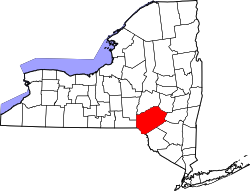Hancock, New York | |
|---|---|
 Hancock Town Square | |
| Motto: Gateway to the Upper Delaware | |
| Coordinates: 41°57′17″N75°17′0″W / 41.95472°N 75.28333°W | |
| Country | United States |
| State | New York |
| County | Delaware |
| Town | Hancock |
| Area | |
• Total | 1.70 sq mi (4.39 km2) |
| • Land | 1.57 sq mi (4.06 km2) |
| • Water | 0.13 sq mi (0.34 km2) |
| Elevation | 922 ft (281 m) |
| Population (2020) | |
• Total | 908 |
| • Density | 579.82/sq mi (223.82/km2) |
| Time zone | UTC-5 (Eastern (EST)) |
| • Summer (DST) | UTC-4 (EDT) |
| ZIP code | 13783 |
| Area code | 607 |
| FIPS code | 36-31940 |
| GNIS feature ID | 0952148 |
| Website | villageofhancockny |
Hancock is a village in Delaware County, New York, United States. The population was 908 at the 2020 census. [2] The village is in the west part of the town of Hancock at the junction of NY Routes 17 and 97.
Contents
Hancock is located at the confluence of the East and West branches of the Delaware River.
Hancock owes its former importance mainly to the Erie Railroad from 1848. The Erie merged into the Erie Lackawanna Railway in 1960. The railroad still exists as the Southern Tier Line of the Norfolk Southern Railway, leased to the Central New York Railroad, but sees only a few freight trains weekly.
The Scranton Branch of the New York, Ontario and Western Railway bridged the West Branch of the Delaware River just west of the village; this railway's main activity in the area was at Cadosia junction, a few miles up the East Branch of the Delaware River. Though the O&W ceased operations on March 29, 1957, the bridge was not removed until the 1970s.


